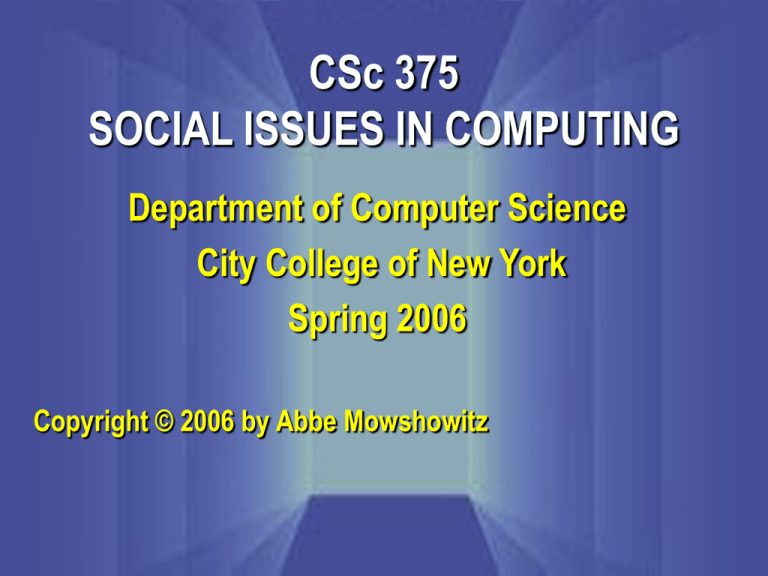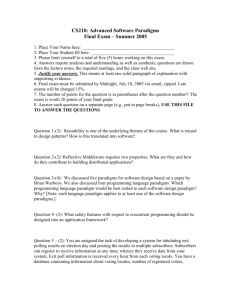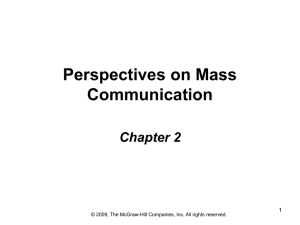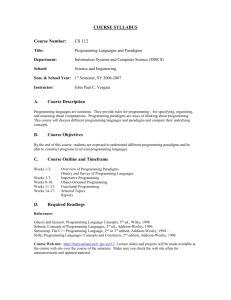375 Lecture Notes - Computer Science
advertisement

CSc 375 SOCIAL ISSUES IN COMPUTING Department of Computer Science City College of New York Spring 2006 Copyright © 2006 by Abbe Mowshowitz TOPIC 6. CONSTRAINTS ON COMPUTER APPLICATIONS A. Introduction: case electronic voting U.S. Touch screens INDIA Buttons & paper slips Paper trails Cannot be reprogrammed/shuts down if opened Name assigned to button at poll 1 jurisdiction Networking 50 jurisdictions TOPIC 6. CONSTRAINTS ON COMPUTER APPLICATIONS A. Introduction (cont.) 1. Indian machine: - voter shows paper ID card - casts ballot by pressing one of the buttons - light glows red and beep emitted - official can shut down system with override - carried physically to counting center (limiting chances of widespread tampering) TOPIC 6. CONSTRAINTS ON COMPUTER APPLICATIONS A. Introduction (cont.) 2. U.S. machines: - MS Windows operating system - back up servers - voice guidance systems - PMCIA storage cards - millions of lines of code - etc. TOPIC 6. CONSTRAINTS ON COMPUTER APPLICATIONS A. Introduction (cont.) 3. Comparison - US system vulnerable to wholesale fraud - Indian system limits fraud since assignment of buttons to candidates is done locally TOPIC 6. CONSTRAINTS ON COMPUTER APPLICATIONS A. Introduction (cont.) 4. Dimensions of difference - wealth - technological capacity - number of electoral jurisdictions TOPIC 6. CONSTRAINTS ON COMPUTER APPLICATIONS A. Introduction (cont.) 5. Another example NASA’s multimillion dollar Astronaut Pen vs. the ordinary Soviet pencil TYPE OF TECHNOLOGY DEVELOPED AND DEPLOYED DEPENDS ON SOCIAL CONDITIONS AND VALUES TOPIC 6. CONSTRAINTS ON COMPUTER APPLICATIONS B. Factors constraining application 1. Overview: three kinds of constraints - intrinsic features (IF) - accidental features (AF) - technocultural paradigms (TP) Universe Of potential applications IF AF TP Realizable Applications TOPIC 6. CONSTRAINTS ON COMPUTER APPLICATIONS B. 2. Intrinsic features - properties of computer hardware, software, systems and networks - requirements for production and deployment of computer technology E.g., until advent of packet switching, networking applications were not feasible TOPIC 6. CONSTRAINTS ON COMPUTER APPLICATIONS B. 3. Accidental features Social context of computer use: activities of individuals and groups that influence the ways computers are used E.g., public and private organizations build computerized personal record systems that threaten privacy TOPIC 6. CONSTRAINTS ON COMPUTER APPLICATIONS B. 4. Technocultural paradigms Values and cultural orientations that create predispositions toward particular uses of technology E.g., belief in desirability of progress provides rationale for use of technology to stimulate growth and change TOPIC 6. CONSTRAINTS ON COMPUTER APPLICATIONS C. Voting machine example re-visited 1. Intrinsic features: technology and financial resources 2. Accidental features: - electoral districts & nature of threats - vested interests in voting machines 3. Technocultural paradigms: addiction to gadgetry TOPIC 6. CONSTRAINTS ON COMPUTER APPLICATIONS D. Other examples 1. Wireless Internet a. Japan - about 63 m mobile Internet users - 60% use iMode platform (compact HTML) -- NTT DoCoMo (leading cellular company) -- always on using packet switching -- 9.6 to 28.8 Kbps; $0.27/100 128B packets TOPIC 6. CONSTRAINTS ON COMPUTER APPLICATIONS D.1. Wireless Internet b. US & Europe - US: fragmented set of mobile network & service standards - Europe: slow adoption of wireless Internet based on WAP TOPIC 6. CONSTRAINTS ON COMPUTER APPLICATIONS D.1.c. Analysis of iMode use in Japan - Internet access without PC - comfortable for wireless users - low initial cost allows trial use - publicity: visible use of phones - established brand/upscale image - group conformity TOPIC 6. CONSTRAINTS ON COMPUTER APPLICATIONS D.1.d. Economic & technological issues in Japan - NTT DoCoMo is market leader - vertical integration - network investment - self-reinforcing services TOPIC 6. CONSTRAINTS ON COMPUTER APPLICATIONS D.1.e. US marketplace - fragmentation & competition in Wireless industry - lack of vertical integration - Internet usage is already high DIFFERENCES EXPLAIN LACK OF IMODE SUCCESS IN THE US TOPIC 6. CONSTRAINTS ON COMPUTER APPLICATIONS D.2. Software development approaches a. Capability Maturity Model (CMM) - incorporates best practices - represents mainstream thinking in software engineering: transform SD from ‘handicraft’ to ‘factory’ system TOPIC 6. CONSTRAINTS ON COMPUTER APPLICATIONS D.2. Software development approaches b. Critique of CMM - SD is environment specific - depends on individuals doing specific tasks - not repetitive in machine-like sense TOPIC 6. CONSTRAINTS ON COMPUTER APPLICATIONS D.2. Software development approaches c. Role of technocultural paradigms - CMM: objectivity & factory - alternative: subjectivity & handicraft PARADIGM INFLUENCES APPROACH TO SOFTWARE DEVELOPMENT TOPIC 6. CONSTRAINTS ON COMPUTER APPLICATIONS E. Concrete historical circumstances of computer use 1. Contemporary conditions - trend toward centralization of control - imbalance: corporations & governments vs. communities & individuals - influence of vested interests backed by substantial resources TOPIC 6. CONSTRAINTS ON COMPUTER APPLICATIONS E. Concrete historical circumstances of computer use 2. Implications of market economy - technology may be owned -- premature deployment -- second best technology - vested interests militate against change TOPIC 6. CONSTRAINTS ON COMPUTER APPLICATIONS E. Concrete historical circumstances of computer use 3. Reinforcement politics - those in power resist efforts to share - computer applications that could distribute power have little chance of success TOPIC 6. CONSTRAINTS ON COMPUTER APPLICATIONS E. Concrete historical circumstances of computer use 4. Tyranny of paradigms - assembly teams vs. assembly lines - large factory vs. networks of small producers (e.g., experience of industrial districts in Italy) TOPIC 6. CONSTRAINTS ON COMPUTER APPLICATIONS E. Concrete historical circumstances of computer use 5. Large scale systems & legal protections - once installed, systems acquire ‘champions’ - unintended uses may come into play - forbidden uses may become acceptable - law as well as custom may change * examples in later topics







